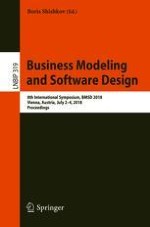The 14 full papers and 21 short papers selected for inclusion in this book deal with a large number of research topics: (i) Some topics concern Business Processes (BP), such as BP modeling / notations / visualizations, BP management, BP variability, BP contracting, BP interoperability, BP modeling within augmented reality, inter-enterprise collaborations, and so on; (ii) Other topics concern Software Design, such as software ecosystems, specification of context-aware software systems, service-oriented solutions and micro-service architectures, product variability, software development monitoring, and so on; (iii) Still other topics are crosscutting with regard to business modeling and software design, such as data analytics as well as information security and privacy; (iv) Other topics concern hot technology / innovation areas, such as blockchain technology and internet-of-things. Underlying with regard to all those topics is the BMSD’18 theme: Enterprise Engineering and Software Engineering - Processes and Systems for the Future.
